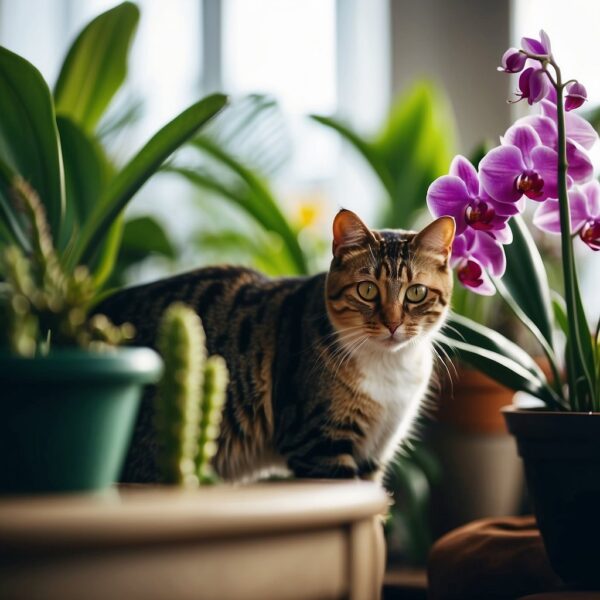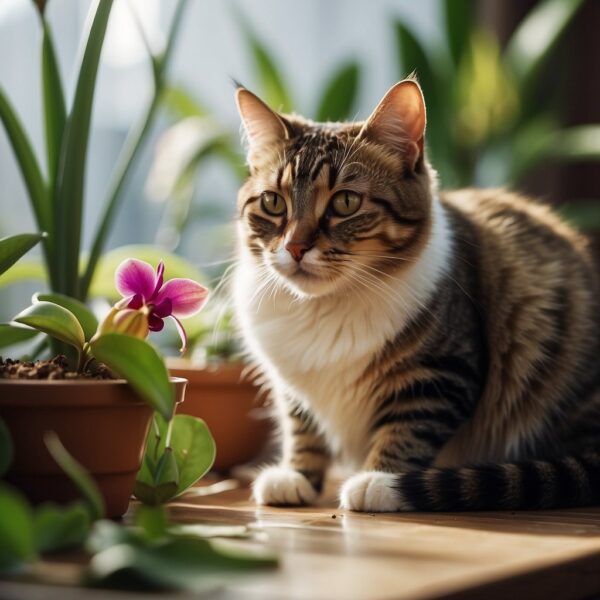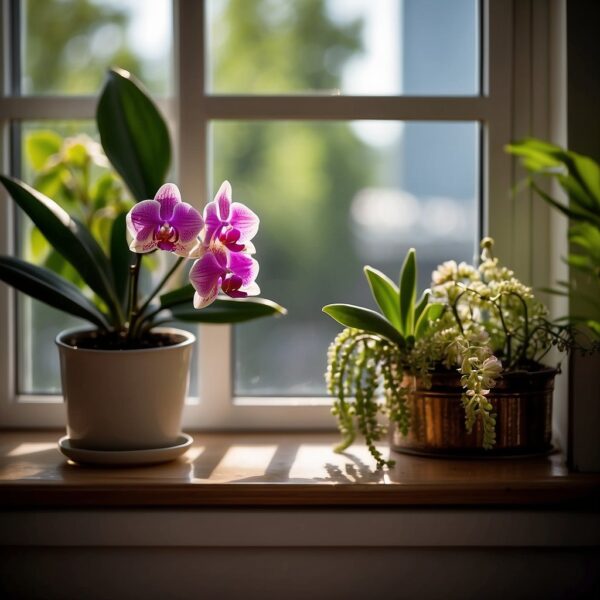
Orchids are not Toxic To Cats
Cats are often curious creatures that enjoy interacting with their environment, which sometimes includes nibbling on household plants. As cat parents, it’s crucial to ensure that the plants within a cat’s reach are safe for them to ingest. Orchids are popular houseplants, cherished for their exotic beauty and vibrant blooms. While there is a vast variety of orchid species, the majority, like those within the Phalaenopsis genus, are non-toxic to cats. This means that having orchids at home generally poses little risk to feline friends when it comes to plant poisoning.
Despite the general safety of orchids, it is still important for cat parents to be vigilant. Not all orchids are created equal, and some species may cause mild stomach upsets if ingested. Additionally, fertilizers or pesticides used on these plants could be harmful to a cat’s health. Recognizing the signs of possible plant poisoning in cats is vital, as is knowing the appropriate first-aid measures and preventive strategies to safeguard pets from potential hazards.
Key Takeaways
- Most orchid species, such as those from the Phalaenopsis genus, are considered non-toxic to cats.
- While orchids themselves are generally safe, some pesticides and fertilizers used on them can be harmful to feline health.
- It is important for guardians to know the signs of plant toxicity in cats and the ways to prevent accidental ingestion.

The Relationship Between Cats and Plants
Cats exhibit natural curiosity towards plants, which can be problematic when considering plant toxicity. Home environments balance cat safety with the aesthetic appeal of houseplants, including popular orchids like Phalaenopsis and Cattleya.
Natural Behaviors of Cats
Cats are inquisitive creatures often intrigued by the texture, movement, and sometimes the taste of plants. Despite being obligate carnivores with dietary needs primarily met through animal protein, they are known to engage in the occasional nibbling of vegetation. This behavior is thought to aid in digestion or fulfill a nutritional need not met by their regular diet.
Common Household Plants and Cats
Houseplants can enhance home environments but may pose risks to cats. Many common plants are toxic to cats and can cause a range of health issues if ingested. Responsible cat parents must differentiate between non-toxic and toxic plants to ensure the well-being of their feline friends when selecting foliage for decoration.
Orchids in the Home Environment
Orchids are considered non-toxic to cats. While not poisonous, cats may still experience mild digestive upset if they eat large quantities of orchid leaves or flowers. Homeowners can confidently display these plants, as they’re a pet-friendly option to brighten living spaces without compromising the safety of their curious cats.
Identifying Toxic and Non-Toxic Plants
When determining which plants are safe for feline companions, it’s vital to differentiate between toxic and non-toxic species. Cats, due to their curious nature, may nibble on household flora. Therefore, cat parents should acquaint themselves with the types of plants that can pose risks.
Non-Toxic to Cats:
- Orchidaceae Family: Popular varieties such as the Phalaenopsis orchids are typically non-toxic. The vast majority of orchids found in homes pose no threat.
- Safe Plants: Deciding on safe greenery entails confirming their non-toxicity to pets. The ASPCA provides a comprehensive list for reference.
Toxic Plants to Avoid:
- Lilies: Many lily species are extremely poisonous to cats and can lead to kidney failure.
- Tulips: The bulb part of tulips contains compounds that can be harmful if ingested.
Cat parents should create a safe environment by selecting non-toxic plants and placing any potentially harmful ones out of the reach of their pets. In any case of ingestion, immediate veterinary consultation is crucial. Here’s a simplified reference table:
| Safe Plants | Unsafe Plants |
|---|---|
| Phalaenopsis Orchids (Orchidaceae) | Lilies |
| Spider Plant | Tulips |
| Boston Fern | Amaryllis |
| Bamboo | Sago Palm |
One should always verify the scientific names of plants, as common names can be misleading. Additionally, bearing in mind that new hybrids or species not yet assessed might present unforeseen risks, caution is advisable when introducing any new plant into a home shared with felines.

Understanding Orchid Toxicity
When examining the potential toxicity of orchids to cats, it’s crucial to understand that most orchids are deemed non-toxic. A primary example is the Phalaenopsis orchid, also known as the moth orchid, which is categorized as safe for cats. This general safety also extends to other popular varieties like the Cattleya orchid.
However, with over 25,000 species in the Orchidaceae family, exceptions exist. The Lady Slipper orchid (Cypripedium) is one such variety that may be toxic if ingested. Cat parents should be cautious and verify the specific type of orchid present in their home.
Toxic effects from orchids are rare but should still be considered. If a cat ingests part of an orchid plant, they might experience gastrointestinal discomfort or other mild symptoms. Here is a brief summary:
| Orchid Type | Toxicity | Concern Level |
|---|---|---|
| Phalaenopsis | Non-toxic | Safe for Cats |
| Cattleya | Non-toxic | Safe for Cats |
| Lady Slipper (Cypripedium) | Potentially Toxic | Use Caution |
In terms of plant parts, if any ingestion occurs, cat parents should monitor their cats for any signs of distress and consult a veterinarian if symptoms arise. Remember that cats are inherently curious, which can sometimes lead them to chew on plants. While orchids are generally safe, its important to prevent frequent nibbling which, beyond potential toxicity, can lead to other issues like vomiting or diarrhea. To ensure a safe environment, it’s always best to keep orchids, especially uncertain species, out of reach from feline friends.
Symptoms of Plant Poisoning in Cats
When a cat has ingested a potentially toxic plant, it may exhibit a range of symptoms that indicate poisoning. Rapid identification and understanding of these symptoms are crucial for a swift and effective response. Guardians should watch for the following signs:
- Gastrointestinal Upset: This can manifest as vomiting or diarrhea. Cats may vomit shortly after consuming a toxic plant, which can help eliminate the substance from their body. However, persisting vomiting and diarrhea require immediate veterinary attention.
- Stomach Upset: Cats might show signs of discomfort, such as whining or restlessness, which can suggest irritation or pain in their stomach.
- Loss of Appetite: Affected cats often lose interest in food. A noticeable decrease in appetite can be a red flag that something is wrong internally.
- Drooling: Excessive salivation or drooling may occur if a cat ingests a toxic plant. This is the body’s reflex to something disagreeable or harmful in the mouth or stomach.
Ingesting toxic plants can lead to more severe symptoms, such as:
- Lethargy: Cats may display overall weakness or lack of energy, which might suggest that the toxin is affecting their system more broadly.
- Gastrointestinal upset: Repeated episodes of vomiting or diarrhea can lead to dehydration and further complications.
Guardians should be aware these symptoms can range from mild to severe. At the first sign of any abnormal behavior or illness, especially after suspected plant ingestion, they should contact a veterinarian. Prompt veterinary care can prevent symptoms from worsening and ensure the cat’s safety and well-being.
First-Aid Measures for Suspected Ingestion
In the instance that a cat ingests orchid parts, the primary goal should be to prevent further ingestion and monitor for signs of gastrointestinal discomfort. Here are the steps one should consider:
- Prevent Further Ingestion: Remove the orchid plant from the cat’s reach immediately.
- Observe: Watch for symptoms like vomiting or diarrhea. These may occur as the cat’s system reacts to the unfamiliar matter.
If vomiting occurs:
- Do Not Induce Vomiting: Let it happen naturally. Forced vomiting is not recommended unless directed by a veterinarian.
- Hydration: Ensure the cat has access to clean water, as vomiting can lead to dehydration.
Contact Veterinarian: As a precaution, the cat parent should:
- Call a local veterinarian or emergency clinic.
- Contact a pet poison hotline if the veterinarian is unavailable.
| Action Step | Description |
|---|---|
| Prevent further ingestion | Keep the cat away from orchids |
| Observe for symptoms | Note any vomiting, diarrhea, or changes in behavior |
| Contact professional help | Veterinarian or poison control hotline |
Treatment: The treatment for orchid ingestion is typically supportive. A veterinarian will likely advise:
- Monitoring at home if symptoms are mild.
- Offering a bland diet for 24 hours if the cat has an upset stomach.
Emergency Care: If symptoms worsen or do not resolve, or if the cat ingests a significant amount of the plant:
- Transportation to a veterinarian office may be necessary.
- Professional evaluation may include physical examination, lab tests, or intravenous fluids.
Prevention: To prevent future incidents, parents should:
- Store orchids and other plants out of the cat’s reach.
- Educate themselves on houseplants that are safe for cats.
Preventive Strategies to Protect Cats
When introducing houseplants such as orchids into a home with cats, prevention of ingestion is key to ensure their safety. While orchids are generally considered non-toxic to cats, it is prudent to prevent cats from nibbling on any plants, as individual cats may have different reactions.
Deterrents: One can lightly coat the leaves with a safe bitter apple spray to discourage a cat’s taste for the plant. It is vital to use only pet-safe deterrents to avoid further health issues.
Placement: Keeping orchids out of reach is an effective strategy. High shelves or hanging baskets serve as excellent options to elevate plants away from curious felines. Ensure that the chosen location is truly inaccessible, as cats are excellent climbers and jumpers.
Physical Barriers: Employ mesh or netting around the plants. This barrier prevents physical access, thus reducing the chance of ingestion. The mesh should be of an appropriate size to prevent paws from reaching in.
Education and Monitoring: Familiarize oneself with the different types of orchids and houseplants, knowing which are safe and which are hazardous. Observe the cat’s behavior around the plants. If a pet shows an inclination to chew on houseplants, more rigorous preventive measures should be put in place.
By implementing these strategies, one creates a safer environment for cats to coexist with orchids and other houseplants. The goal is to protect the cat first.

Selecting Safe Orchids and Alternatives
When selecting orchids for a household with cats, safety is paramount. Phalaenopsis orchids, commonly known as moth orchids, are a safe choice, as they are typically non-toxic to cats. Parents can confidently display these plants without fear of pet health risks from ingestion.
Additionally, there are several pet-friendly alternatives to orchids that are considered non-toxic and safe for cats. Here are some popular options that can add greenery to a home while keeping feline friends secure:
- Cat Grass: Grown from oat or wheat seeds, this plant is not only safe but also beneficial as it aids in a cat’s digestion.
- Catnip: A well-known favorite for cats, it can provide stimulation and is safe for consumption.
- Spider Plant: With its striking foliage, it is non-toxic, and its quick growth rate and easy care make it a resilient choice.
For parents wanting to maintain a harmonious and cat-safe environment, consider the following table of alternatives:
| Non-Toxic Plants | Benefits for Cats | Maintenance |
|---|---|---|
| Cat Grass | Aids digestion | Low; grows quickly |
| Catnip | Provides stimulation | Low; drought-tolerant |
| Spider Plant | Safe for play | Low; resilient |
It’s essential for cat parents to research and verify the safety of plants before bringing them into homes shared with cats. When in doubt, consulting a veterinarian can provide peace of mind and ensure a cat-friendly living space.
cats and Orchids: Frequently Asked Questions
Cats and orchids can coexist safely, as most orchid species pose no toxic threat to cats. Nevertheless, it’s important for cat owners to understand how to manage this coexistence to ensure their cats stay safe and their plants remain undisturbed.
What are the risks of cats being exposed to orchids?
The primary risk of cats being exposed to orchids is the potential for digestive upset. While orchids are generally not toxic to cats, ingestion can sometimes cause mild stomach discomfort.
How can I prevent my cat from eating my orchids?
Cat parents can prevent their cats from eating orchids by placing the plants out of reach, using deterrent sprays on the orchids, or providing their cats with alternative plants to chew on that are known to be safe.
What should I do if my cat ingests part of an orchid?
If a cat ingests part of an orchid, monitoring the cat for any signs of gastrointestinal upset is advisable. Typically, no medical intervention is necessary, but if symptoms persist or worsen, contacting a veterinarian is recommended.
Which orchid varieties are safe for homes with cats?
Most orchid varieties, such as the popular Phalaenopsis, are safe for homes with cats. These plants are not listed as toxic to cats by major animal welfare organizations.
How can I identify if an orchid is dangerous for my cat?
To identify if an orchid is dangerous for a cat, guardians should research the specific orchid species. Consultation with a veterinarian or referencing databases from animal poison control centers can also provide valuable information.
What are the signs of orchid toxicity in cats?
Signs of orchid toxicity in cats, which are rare, may include gastrointestinal upset such as vomiting or diarrhea. If a cat displays such symptoms after ingesting any plant material, seeking veterinary advice is crucial.